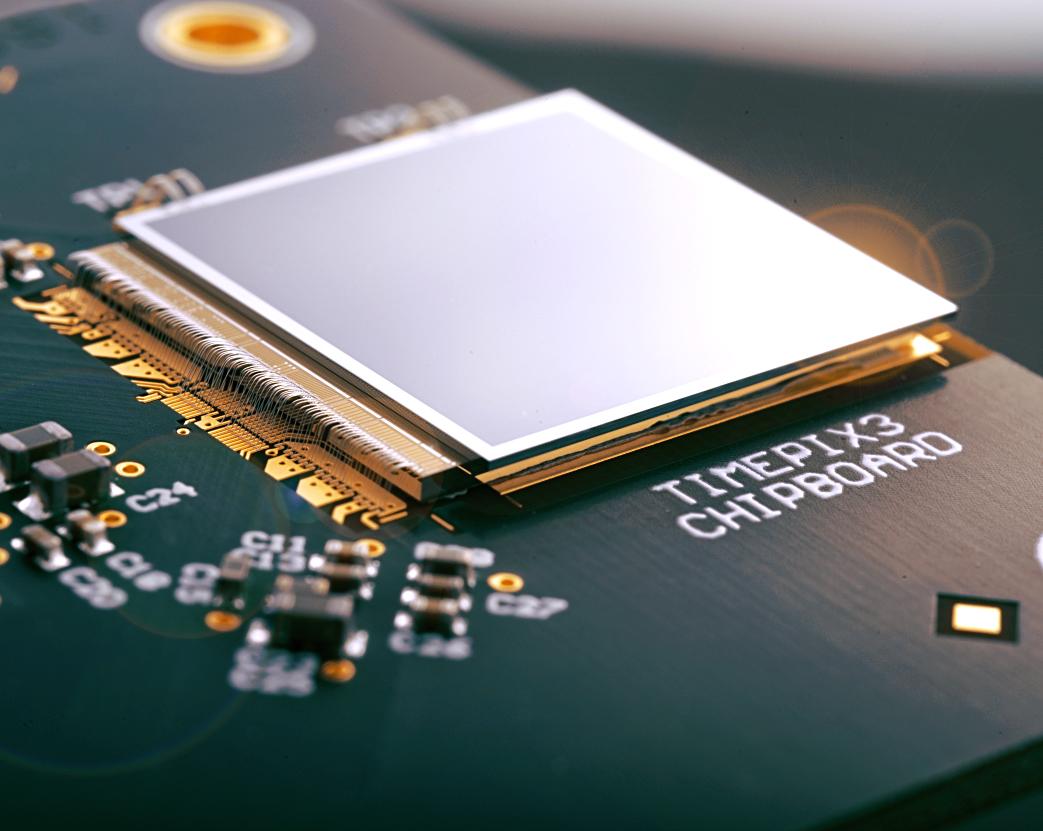Timepix3 is a general-purpose integrated circuit suitable for readout of both semiconductor detectors and gas-filled detectors. Compared to Timepix1 the circuit has more functionality, better time resolution and more advanced architecture for continuous sparse data readout with zero-suppression. Timepix3 can be used in a wide range of applications varying from X-rays imaging to particle track reconstruction.
Depending on the application requirements user can choose one out of three data acquisition modes available in the Timepix3. In the data driven mode both arrival time information and charge deposit information are sent off chip for each hit together with the coordinates of the active pixel. The chosen architecture allows for continuous and trigger-free readout of sparsely distributed data with the rate up to 40Mhits/s/cm2. For imaging applications and for calibrations the possibility exists of operating in frame-based (non-continuous) data readout mode.
In 2017, Amsterdam Scientific Instruments (ASI), a spin-off from Nikhef, the Dutch Institute of Particle Physics, acquired a license from CERN for the TIMEPIX3 technology, a core component for ASI’s next generation hybrid pixel cameras. Read more here.
Advantages & Applications
Features
- Pixel size 55μm x 55μm
- 256 x 256 pixels
- Timepix3 is suitable for readout of both semiconductor detectors and gas-filled detectors
- Single thresholds per pixel each with 4 bits of local adjustment
- Two main measurement modes: (1) simultaneous 10 bit ToT and 18 bit TOA and (2) 10 bit event counting and 14 bit integral TOT
- TOT monotonic for large positive charges
- Fast TOA for time stamping with a precision of 1.56 ns
- Data driven readout: dead time free, for a maximum hit rate of 40 Mhits/s/cm2
- Shutdown/wake-up features for power pulsing tests on a full system
- 3-side buttable (with a single 1.2mm dead edge)
- TSV ready
Applications
- X-rays imaging
- Particle track reconstruction.
- Timepix3 is suitable for readout of both semiconductor detectors and gas-filled detectors.
Specifications
| General | |
|---|---|
| CMOS technology | 0.13μm |
| Pixel size | 55μm x 55μm |
| Pixel matrix | 256 x 256 |
| Design | CERN, NIKHEF, Bonn University |
| Analog front end (pixel cell) | |
|---|---|
| Signal polarity | Positive and negative |
| Leakage current | -10nA to +20nA |
| TOA jitter and mismatch | Compatible with 1.56ns resolution (gas detector applications) |
| Time to peak | 25ns |
| Noise | 62 e- rms |
| Threshold variation (after tuning) | 30 e- rms |
| Minimum operating treshold | 500 e- |
| Digital part (pixel cell + periphery) | |
|---|---|
| TOA precision | 1.56ns |
| Number of bits per hit | 48 |
| Data sent per hit | x, y TOT (10 bits) TOA (18 bits) |
| Readout uses up to 8 parallel LVDS lines (200 MHZ clock) | |
| Total analog power consumption (nominal conditions) | 440mW |
| Total digital power consumption (@100MHz) | 450mW |

